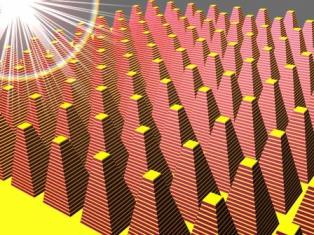While providing an overview of different types of narrowband electromagnetic absorbers, researchers from the Zhejiang University in Hangzhou and the Taiyuan University of Technology in China point out ways to create effective broadband/multiband absorbers with crucial applications in fields like solar-energy harvesting.
The review article “Plasmonic and metamaterial structures as electromagnetic absorbers,” published in Lasers & Photonics Reviews, begins in 1902, when R.W. Wood observed the anomalous dips in the reflection spectra of metallic gratings when illuminated by a white-light source.The scientists described how electromagnetic wave absorbers have developed over the years to become devices that efficiently absorb radiation from operating wavelengths, which can be then turned into other forms of energy, ideally producing neither transmission nor reflection.
Following the historical overview, the scientists then described what materials and configurations are being used in modern absorbers, such as lamellar gratings, convex grooves, spherical voids, and hole arrays, all made of noble metals. These absorbers are associated with plasmonics that demonstrate unique phenomena because of the excitation of planar or localized SPPs (surface plasmon polaritons).
Along with absorbers that operate via plasmonic effects, the scientists also discussed the burgeoning field of metamaterials, which are also used in many EM absorbers. Metamaterials are artificial assemblages of structured elements that are much smaller in size than the incident waves. Depending on how the metamaterials are designed, engineers can modulate the permittivity and permeability of the device from zero to infinity. Because of this, metamaterials can yield unique properties that cannot be found in nature; thus, metamaterials can be tailor-made to become “the perfect absorber,” and are undergoing increased miniaturization and development.

In addition to reviewing the principles behind a range of narrowband EM absorbers, the researchers also discuss ways to improve their performance. Additionally – and importantly – the article discusses ways to use some of the principles behind narrowband EM absorbers to create multiband or broadband EM absorbers. Though narrowband EM absorbers are useful and necessary in such applications as selective thermal emitters and biosensing, other applications – for example, solar-energy harvesting and photonic detection – require broad bandwidth.
“The most profound application area of EM absorbers is solar-energy harvesting. Every improvement to the performance of solar-energy-harvesting devices is of great significance to society, bringing both economic and environmental benefits,” the article postulated. “In the future, low-cost, easily fabricated, and high-performance solar absorbers will be in high demand for building economic solar plants.”
The scientists suggested various ways of creating broad/multiband EM absorbers, such as exciting phase resonances, combining multiple resonances together, slowing down light via anisotropic metamaterials, and using high-loss materials.
“The increasing pace in the development of EM absorbers has already resulted in many important achievements,” the article stated. “Ascribed to the versatility of forms of plasmonic or photonic modes, the mechanisms of EM absorbers are diverse… Fortunately, whether the band is required to be broad or narrow, angle insensitive or sensitive, all can be realized by EM absorbers with specific geometries.”
While the scientists are optimistic about the usefulness of EM absorbers, as well as its rate of development, they voice some cautionary words about the technology’s future.
“Overall, while high-performance EM absorbers have great potential in many applications, their industrial realization remains a formidable challenge to overcome,” the article concluded.
– Melanie Abeygunawardana






